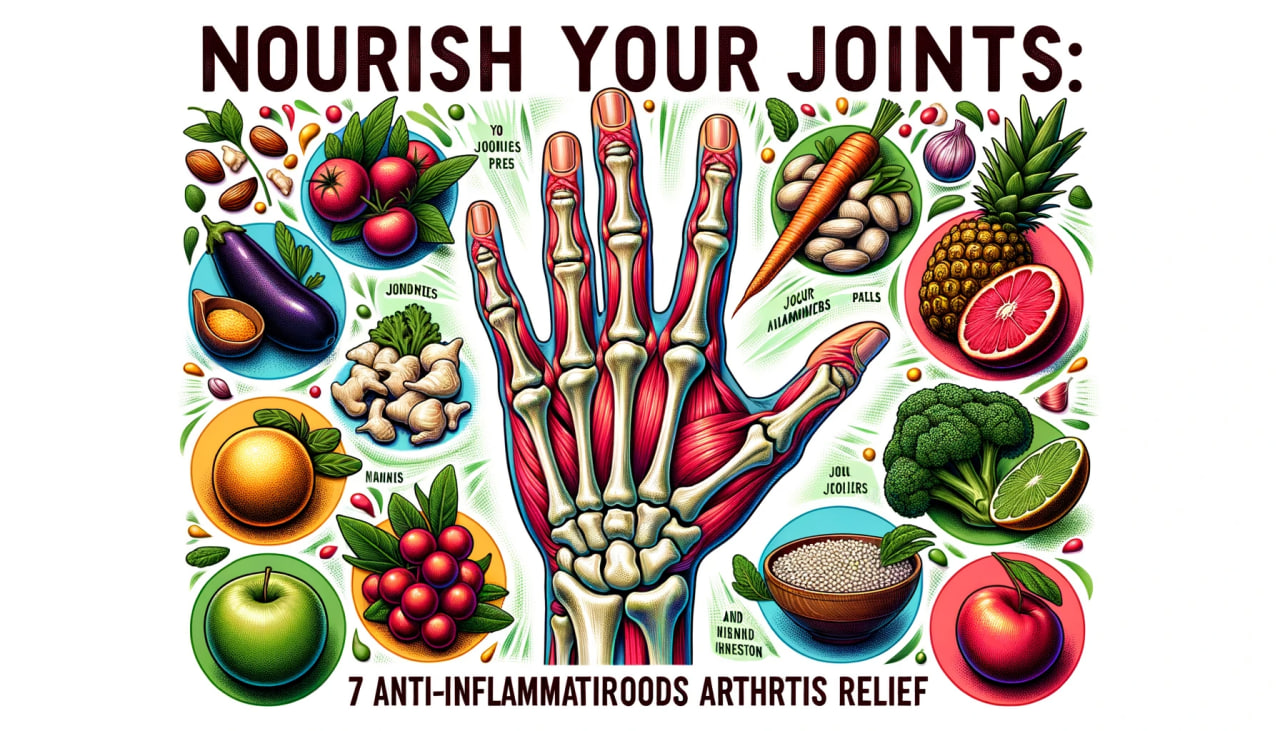Introduction
Arthritis is a common condition that affects millions of people worldwide. It is characterized by joint inflammation and stiffness, leading to pain and discomfort. While various medications and treatments are available, incorporating anti-inflammatory foods into your diet can help alleviate arthritis symptoms. These foods are rich in nutrients and compounds that can help reduce inflammation, providing much-needed relief for those with arthritis. In this blog post, we will discuss seven anti-inflammatory foods that you can easily incorporate into your diet to nourish your joints and find relief from arthritis pain.
1) Understanding Arthritis and its Impact on Quality of Life
Living with arthritis can significantly impact an individual’s quality of life. The inflammation and stiffness in the joints can make even simple everyday tasks a challenge. The pain and discomfort associated with arthritis can limit mobility and hinder independence. It can affect work productivity, personal relationships, and overall mental well-being.
Arthritis causes physical limitations and takes an emotional toll on individuals. Constant pain and fatigue can lead to frustration, anxiety, and depression. It can feel like a never-ending battle, constantly seeking relief and trying to find ways to manage the symptoms.
It is essential to understand the impact arthritis has on one’s quality of life to take proactive steps towards managing the condition. By incorporating anti-inflammatory foods into the diet, individuals with arthritis can nourish their joints and relieve pain and discomfort. This can improve mobility, reduce inflammation, and ultimately enhance overall well-being.
2) Role of Diet in Arthritis Management
Diet plays a crucial role in the management of arthritis. While medications and treatments can provide relief, incorporating the right foods into your diet can significantly improve your overall well-being. A healthy and balanced diet can help reduce inflammation, strengthen the immune system, and nourish your joints.
Certain foods, primarily those rich in antioxidants, omega-3 fatty acids, and polyphenols, have been found to have anti-inflammatory properties. These foods can help alleviate arthritis symptoms and improve joint health. By including various fruits, vegetables, whole grains, lean proteins, and healthy fats in your diet, you can provide your body with the nutrients it needs to combat inflammation.
Avoiding or limiting foods that may contribute to inflammation is also essential. This includes processed foods, refined sugars, saturated fats, and excessive alcohol consumption. These foods can increase inflammation in the body and exacerbate arthritis symptoms.
In addition to incorporating anti-inflammatory foods, maintaining a healthy weight through proper nutrition can benefit individuals with arthritis. Excess weight can strain the joints, leading to increased pain and discomfort. Following a balanced diet and regular exercise can help manage your weight and reduce the burden on your joints.
3) What Makes a Food Anti-Inflammatory?
To understand what makes a food anti-inflammatory, it’s essential first to understand the role of inflammation in arthritis. When arthritis flares up, the body’s immune system releases chemicals that cause inflammation, leading to pain and discomfort. Anti-inflammatory foods work by reducing this inflammation and providing relief.
One key factor in anti-inflammatory foods is their nutrient content. Foods high in antioxidants, such as fruits and vegetables, help neutralize free radicals in the body, which can contribute to inflammation. Omega-3 fatty acids, found in fatty fish like salmon and sardines, as well as in walnuts and flaxseeds, are also known for their anti-inflammatory properties. These fatty acids help to regulate the body’s immune response and decrease inflammation.
Polyphenols, another critical group of compounds found in foods like green tea, dark chocolate, and berries, also have potent anti-inflammatory effects. They can inhibit the production of inflammatory markers in the body, reducing inflammation.
Additionally, foods that are rich in fiber, such as whole grains and legumes, have been shown to have anti-inflammatory effects. Fiber helps to promote a healthy gut microbiome, which plays a role in immune function and inflammation.
4) The Top 7 Anti-Inflammatory Foods for Arthritis Relief
Arthritis can be debilitating, but incorporating anti-inflammatory foods into your diet can provide much-needed relief. Here are the top 7 anti-inflammatory foods to help alleviate arthritis symptoms and nourish your joints.
1) Fatty Fish: Rich in omega-3 fatty acids, fish like salmon, sardines, and mackerel have been shown to reduce inflammation in the body. These healthy fats can help ease joint pain and stiffness.
2) Berries: Packed with antioxidants and polyphenols, berries like strawberries, blueberries, and raspberries have strong anti-inflammatory properties. They can help reduce inflammation and protect against joint damage.
3) Leafy Greens: Kale, spinach, and other leafy greens are high in vitamins and minerals, as well as antioxidants. These nutrients can help reduce inflammation and support joint health.
4) Turmeric: Known for its vibrant yellow color and anti-inflammatory properties, turmeric contains curcumin that can help alleviate arthritis symptoms. Try adding it to curries, smoothies, or golden milk.
5) Ginger: Ginger has been used for centuries to reduce inflammation and ease joint pain. It can be consumed fresh, dried, or as a tea.
6) Nuts: Walnuts, almonds, and other nuts are rich in omega-3 fatty acids and antioxidants, making them an excellent choice for fighting inflammation. They can be enjoyed as a snack or added to salads and other dishes.
7) Olive Oil: Extra virgin olive oil is delicious and a great source of monounsaturated fats and antioxidants. It can help reduce inflammation and promote joint health when used in moderation.
5) Tasty and Healthy Recipe Ideas Using These Foods
Are you ready to spice up your meals while nourishing your joints? Here are some tasty and healthy recipe ideas incorporating the top 7 anti-inflammatory foods for arthritis relief.
1) Fatty Fish: Try grilled salmon with a tangy lemon dill sauce. Pair it with roasted vegetables for a nutritious and flavorful meal.
2) Berries: Whip a refreshing berry smoothie by blending strawberries, blueberries, and almond milk. You can also add a scoop of protein powder for an extra nutritional boost.
3) Leafy Greens: Create a vibrant salad with kale, spinach, and arugula. Top it with roasted chickpeas, sliced almonds, and a drizzle of olive oil and balsamic vinegar.
4) Turmeric: Make a comforting turmeric latte combining almond milk, turmeric powder, cinnamon, and honey. It’s the perfect cozy beverage for a chilly evening.
5) Ginger: Stir-fry your favorite vegetables with fresh ginger, garlic, and soy sauce for a zesty and aromatic dish. Serve it over brown rice or quinoa for a complete meal.
6) Nuts: Sprinkle crushed walnuts over a mixed green salad with sliced strawberries and goat cheese. Drizzle with a honey mustard dressing for a delicious and nutritious salad.
7) Olive Oil: Roast a medley of vegetables like zucchini, bell peppers, and red onions in olive oil, garlic, and herbs. Serve as a side dish or toss with whole wheat pasta for a satisfying main course.

These recipe ideas are just the beginning. Get creative in the kitchen and explore different anti-inflammatory food combinations to find the best flavors. Enjoy nourishing your joints and indulging in delicious meals that support your overall well-being.
6) Making Smart Dietary Choices: Tips for Implementing These Foods into Your Routine
Making smart dietary choices and incorporating anti-inflammatory foods into your routine is essential to managing arthritis and improving overall well-being. Here are some tips to help you implement these foods into your daily routine.
Start small: Introduce one or two new anti-inflammatory foods at a time. This will allow you to gradually adjust your taste buds and find new ways to incorporate them into your meals.
Experiment with recipes: Explore different recipes that feature the anti-inflammatory foods you enjoy. Get creative in the kitchen and try out new flavors and combinations. This will make your meals more exciting and enjoyable.
Meal prep: Plan your meals and include anti-inflammatory foods in your grocery list. Prepped ingredients and meals will make sticking to your dietary goals easier and ensure you have readily available, nutritious options.
Replace unhealthy options: Instead of reaching for processed snacks or sugary desserts, opt for anti-inflammatory alternatives. For example, swap out potato chips for a handful of mixed nuts or indulge in a piece of dark chocolate instead of a sugary treat.
Stay hydrated: Hydration is crucial for overall health and joint function. Make sure to drink plenty of water throughout the day. You can also incorporate hydrating foods like cucumbers, watermelon, and celery into your meals and snacks.
Consult a professional: If you’re unsure how to incorporate anti-inflammatory foods into your diet or have specific dietary restrictions, consider consulting a healthcare professional or registered dietitian. They can provide personalized recommendations and guidance based on your individual needs.
By making smart dietary choices and implementing these tips, you can nourish your joints and relieve arthritis symptoms. Consistency is critical, so be patient with yourself as you transition to a healthier eating routine.
Incorporating These Foods Into Your Grocery List and Meal Planning
When incorporating anti-inflammatory foods into your diet for arthritis relief, one of the first steps is to add these foods to your grocery list and make a meal plan that includes them. By being intentional about your food choices and planning, you can ensure that you always have these beneficial ingredients.
Start by listing the top 7 anti-inflammatory foods mentioned in this blog post: fatty fish, berries, leafy greens, turmeric, ginger, nuts, and olive oil. When you go grocery shopping, pick up these items so they are readily available when you’re ready to cook or snack.
Next, consider incorporating these foods into your meal planning. Consider the meals and snacks you enjoy and find creative ways to include these ingredients. For example, add berries to your morning oatmeal, incorporate leafy greens in your salads, or use olive oil as a dressing or cooking oil.
It can also be helpful to prepare ingredients in advance. For instance, you can wash and chop your leafy greens, dice ginger, or portion nuts into snack-sized bags. Having these items prepped and ready to go will make it easier to incorporate them into your meals throughout the week.
Herbs and Spices: The Secret Ingredients to Boost Anti-Inflammatory Power
Herbs and spices are not only great for adding flavor to your dishes, but they also possess potent anti-inflammatory properties. By incorporating these secret ingredients into your meals, you can boost the anti-inflammatory power of your diet and find additional relief from arthritis symptoms.
Turmeric, one of the key ingredients in curry powder, contains a compound called curcumin that has been shown to reduce inflammation in the body. Sprinkle turmeric into your curries, soups, or smoothies for an extra anti-inflammatory kick.
Ginger, another spice with potent anti-inflammatory effects, can be added to stir-fries, marinades, or even brewed as a tea. It provides a warm and zesty flavor while helping to alleviate joint pain and inflammation.
Cinnamon, often used in sweet dishes, also has anti-inflammatory properties. Sprinkling it over your oatmeal, yogurt, or coffee adds a delicious and comforting flavor.
Rosemary, thyme, and oregano are herbs that enhance the taste of your dishes and have anti-inflammatory properties. Use them to season roasted vegetables, meats, or soups for a flavorful and healthy boost.
Incorporating these herbs and spices into your meals can add depth and flavor to your dishes while maximizing the anti-inflammatory benefits. Get creative in the kitchen and experiment with different combinations to find your favorite flavors and reap the benefits of these secret ingredients.
Get Creative in the Kitchen: More Ways to Incorporate Anti-Inflammatory Foods into Your Diet
Are you tired of eating the same old meals every day? Well, it’s time to get creative in the kitchen and find new and exciting ways to incorporate anti-inflammatory foods into your diet. Adding these foods to your meals doesn’t have to be boring or bland; it can be pretty delicious and satisfying!
One way to get creative is by experimenting with different flavors and spices. For example, add a pinch of turmeric to your scrambled eggs or sprinkle some cinnamon on your roasted sweet potatoes. These simple additions add an extra burst of flavor and boost the anti-inflammatory power of your meals.
Another way to incorporate anti-inflammatory foods is by trying out new recipes. Have you ever tried making a cauliflower pizza crust or a quinoa salad with roasted vegetables? These dishes are not only nutritious but also incredibly tasty. Don’t be afraid to step out of your comfort zone and try something new; you might discover a fresh favorite meal!
You can also make your meals more colorful and appealing by incorporating a variety of fruits and vegetables. Create a vibrant stir-fry with bell peppers, broccoli, and snap peas, or make a refreshing salad with watermelon, feta cheese, and mint. By including a rainbow of produce in your meals, you get a wide range of nutrients and make your plate look more appetizing.
Listen to Your Body: How to Determine Which Anti-Inflammatory Foods Work for You
As you embark on your journey to incorporate anti-inflammatory foods into your diet, it is essential to listen to your body and determine which foods work best for you. Everyone is unique, and what may work for one person may not necessarily work for another. Pay attention to how your body responds to different foods and adjust accordingly.
Start by keeping a food journal or diary to track your meals and any symptoms or changes you notice. This can help you identify patterns and determine which foods may be triggering inflammation or causing discomfort. Working with a healthcare professional or registered dietitian who can provide guidance and support can also be helpful.
Additionally, be mindful of any allergies or intolerances you may have. Some anti-inflammatory foods, such as nuts or seafood, may cause adverse reactions in specific individuals. If you notice any negative symptoms after consuming a particular food, it may be best to avoid it and find alternatives that provide similar benefits.
Finding the right anti-inflammatory foods for your body may take time and experimentation. Be patient with yourself and celebrate small victories along the way. By listening to your body and making adjustments as needed, you can create a personalized anti-inflammatory diet that supports your arthritis relief and overall well-being.

